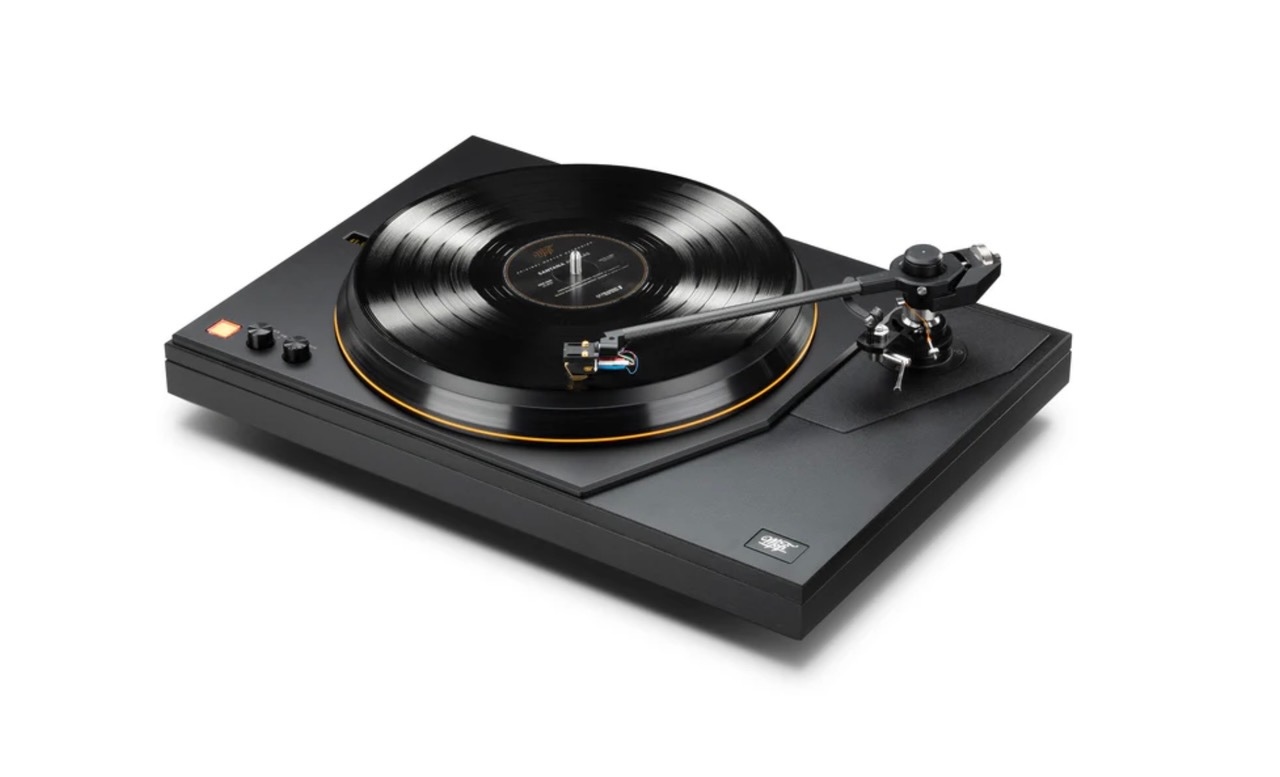Made In America MasterDeck Turntable— Original Thinking In Design and Execution
gives you well more than what you paid for
Taking a lunch break during a mid 1990’s Consumer Electronics Show, Allen Perkins, then working for turntable manufacturer SOTA and I writing for The Absolute Sound, exited The Riviera Hotel, site of the “high end” exhibits, and took a walk along Las Vegas Boulevard, better known as “The Strip”.
The west side of the street then was mostly demolished brick rubble behind chain link fencing. Among the few buildings on that side of the street was the old blue backlit Caesar’s Palace, opened in 1966.
We were both unhappy with our employment situations, though to be clear SOTA and TAS were then owned and operated by different entities.
Within a few years I was happily writing for Stereophile and building an online presence, and Perkins had created Immedia and designed a few turntables and tonearms. The RPM-2 turntable and RPM-2 tonearm both introduced around 1997 were destined to become classics even if you’re unfamiliar. Classics because the turntable’s industrial look has been copied by many others as has the tonearm’s brilliant conceptual design and execution, which I won’t go into here because it’s ancient history. You can snoop the web and see for yourself.
Perkins later designed, manufactured and marketed the Spiral Groove turntable series and Centroid tonearm, both of which furthered his unique ideas. The SG1.2 with Centroid arm sold for $36,000. A few years ago after Perkins stopped producing his own turntables Mofi Distribution hired Perkins as a consultant when it launched Mo-Fi Electronics. He designed a series of turntables for its brand, culminating in this, the made in Ann Arbor, Michigan MasterDeck turntable, which sells for $5995 complete with tonearm.
Knowing Perkins as I do, I’m certain he found it far more difficult and probably somewhat frustrating to compromise a design, but that was the assignment so let’s look at what he’s done.
Skillfully Pared Down Design
It wouldn't be an exaggeration to consider the MasterDeck as the "budget priced" Spiral Groove turntable Perkins never built for his own company. The platter bearing—a key to any turntable's claim for "quiet", speed accuracy and platter stability—is an inverted encapsulated design similar to the Spiral Groove's unique bearing, which is squat and aligns the rotational axis with the belt, resulting in exceptional platter stability. The machining produces width above and below the point of rotation, which enhances rotational stability. The specially chosen sintered bronze bushing (shown in a photo below) contacts the bearing only at those two points. Some vinyl enthusiasts think a long platter bearing and bushing produces a superior outcome—the longer the better— but the opposite (up to a point!) is true. The half-moon disc at the top left is the partially obscured motor above which is the pulley.
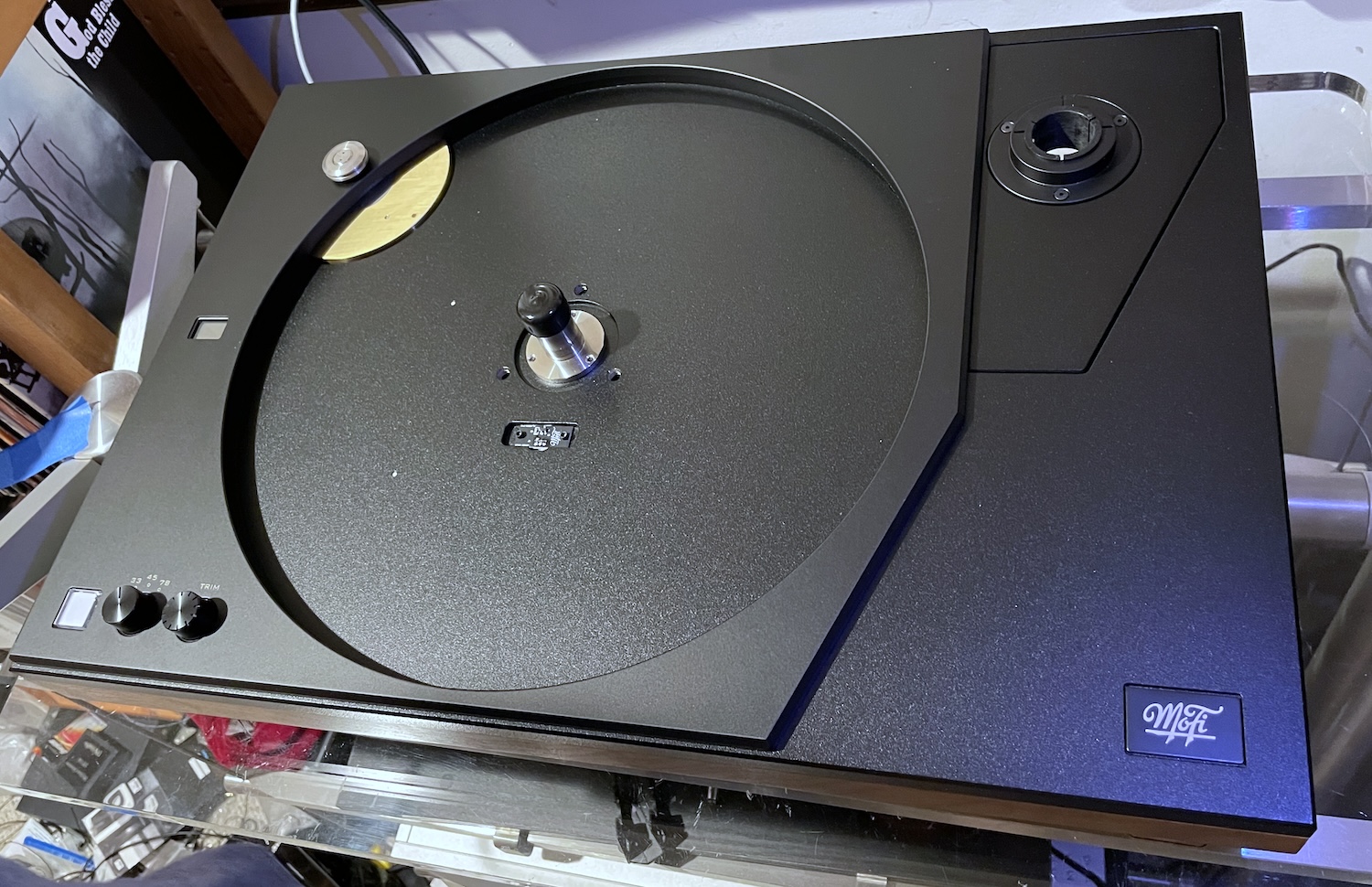 In the photo below you can see the color differential produced by the bushing contacting the raised area of the spindle (this 'table had been previously broken in before delivery). The upper one is covered by the cap. You can also better see the reader that monitors speed, but only at start-up. It's not there to constantly monitor and "hunt and peck" for the correct speed.
In the photo below you can see the color differential produced by the bushing contacting the raised area of the spindle (this 'table had been previously broken in before delivery). The upper one is covered by the cap. You can also better see the reader that monitors speed, but only at start-up. It's not there to constantly monitor and "hunt and peck" for the correct speed.
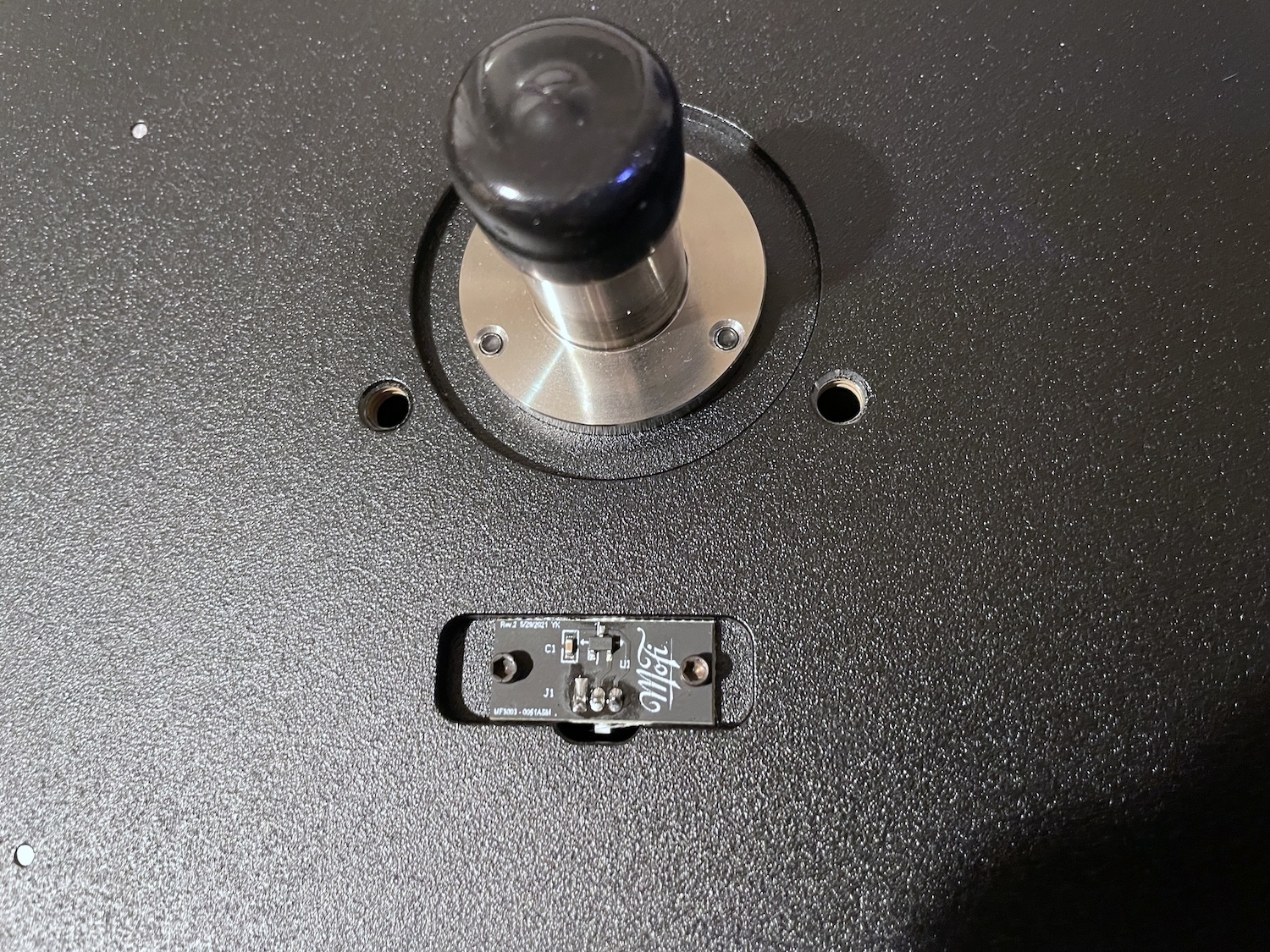 The below illustration from the instruction manual further clarifies it. The result is minimal contact between the platter bushing and the bearing, plus far greater rotational stability compared to long "standard" spindle bearings.
The below illustration from the instruction manual further clarifies it. The result is minimal contact between the platter bushing and the bearing, plus far greater rotational stability compared to long "standard" spindle bearings.
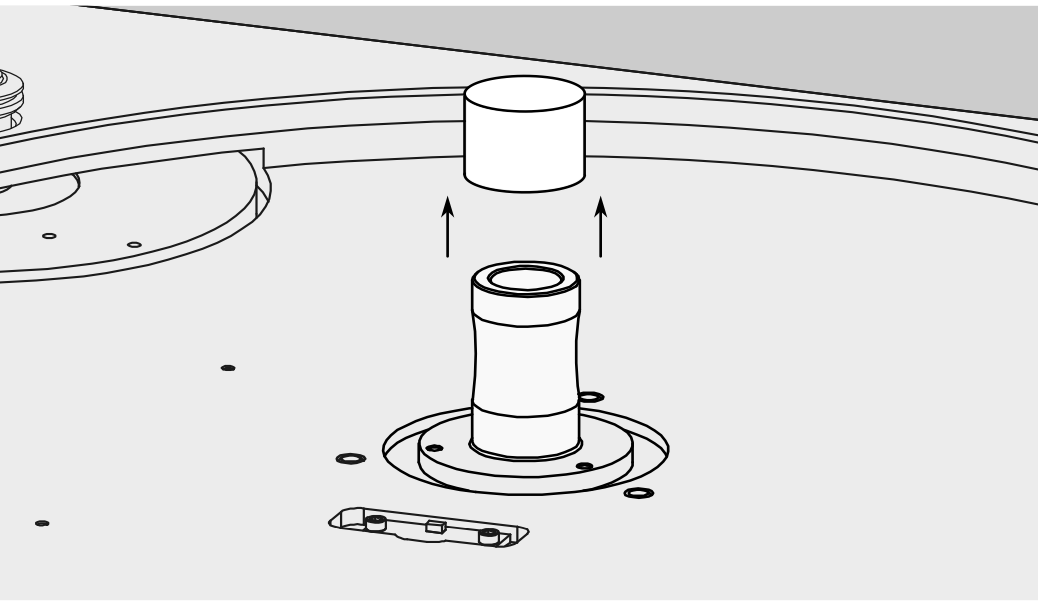 The almost 14.5 pound, 1.75 inch tall tapered platter of Delrin and aluminum is taller than it appears once installed since it's partially hidden within the plinth cut out. The photo also shows the platter's sintered bronze bushing insert. You can see the four tiny magnetic discs that the plinth-mounted reader uses to monitor speed.
The almost 14.5 pound, 1.75 inch tall tapered platter of Delrin and aluminum is taller than it appears once installed since it's partially hidden within the plinth cut out. The photo also shows the platter's sintered bronze bushing insert. You can see the four tiny magnetic discs that the plinth-mounted reader uses to monitor speed.
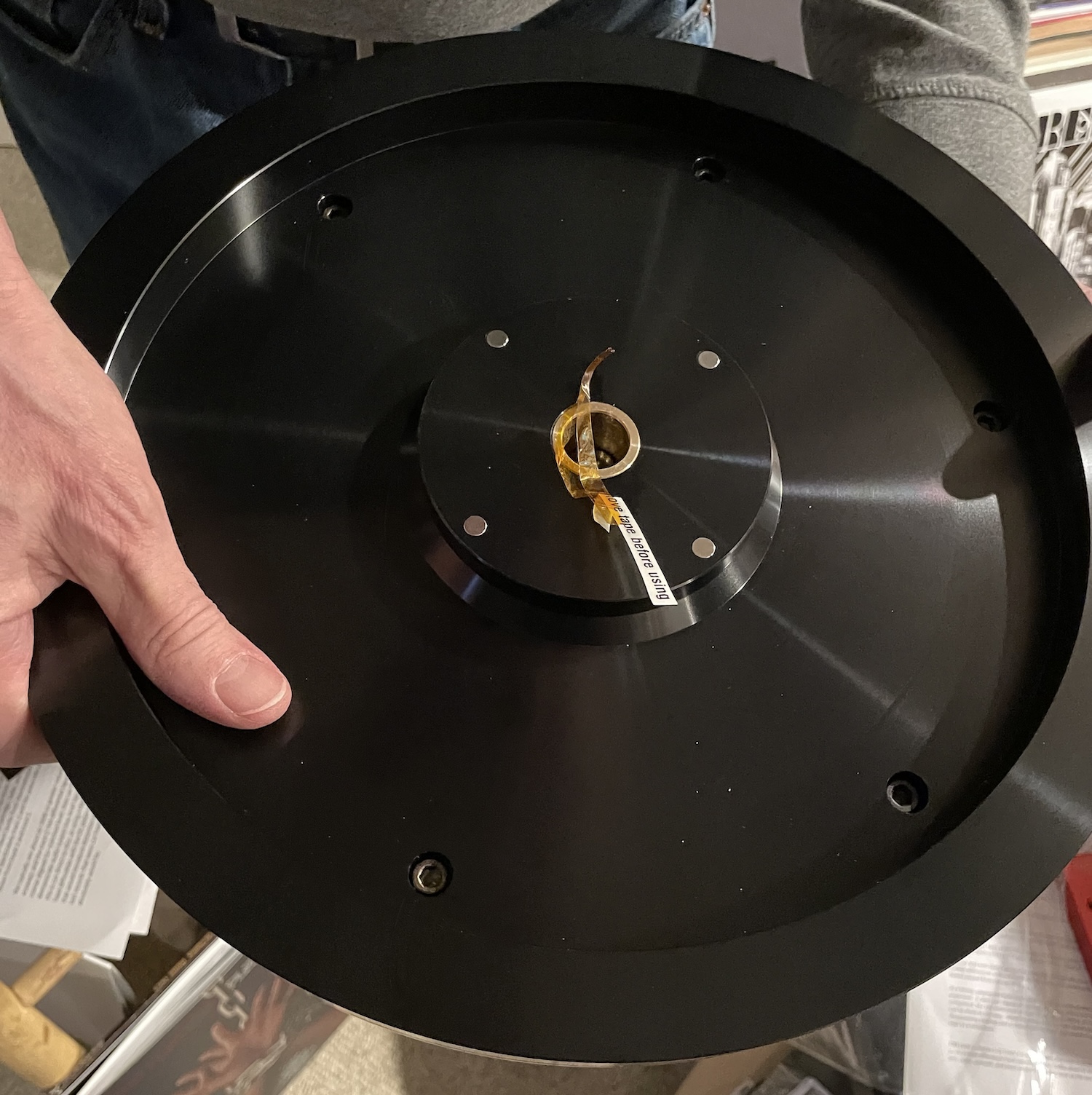 The designer holds the platter upside down
The designer holds the platter upside down
The spindle is isolated from the bearing to reduce noise produced at the inverted bearing interface, which consists of a steel ball and Teflon thrust pad.
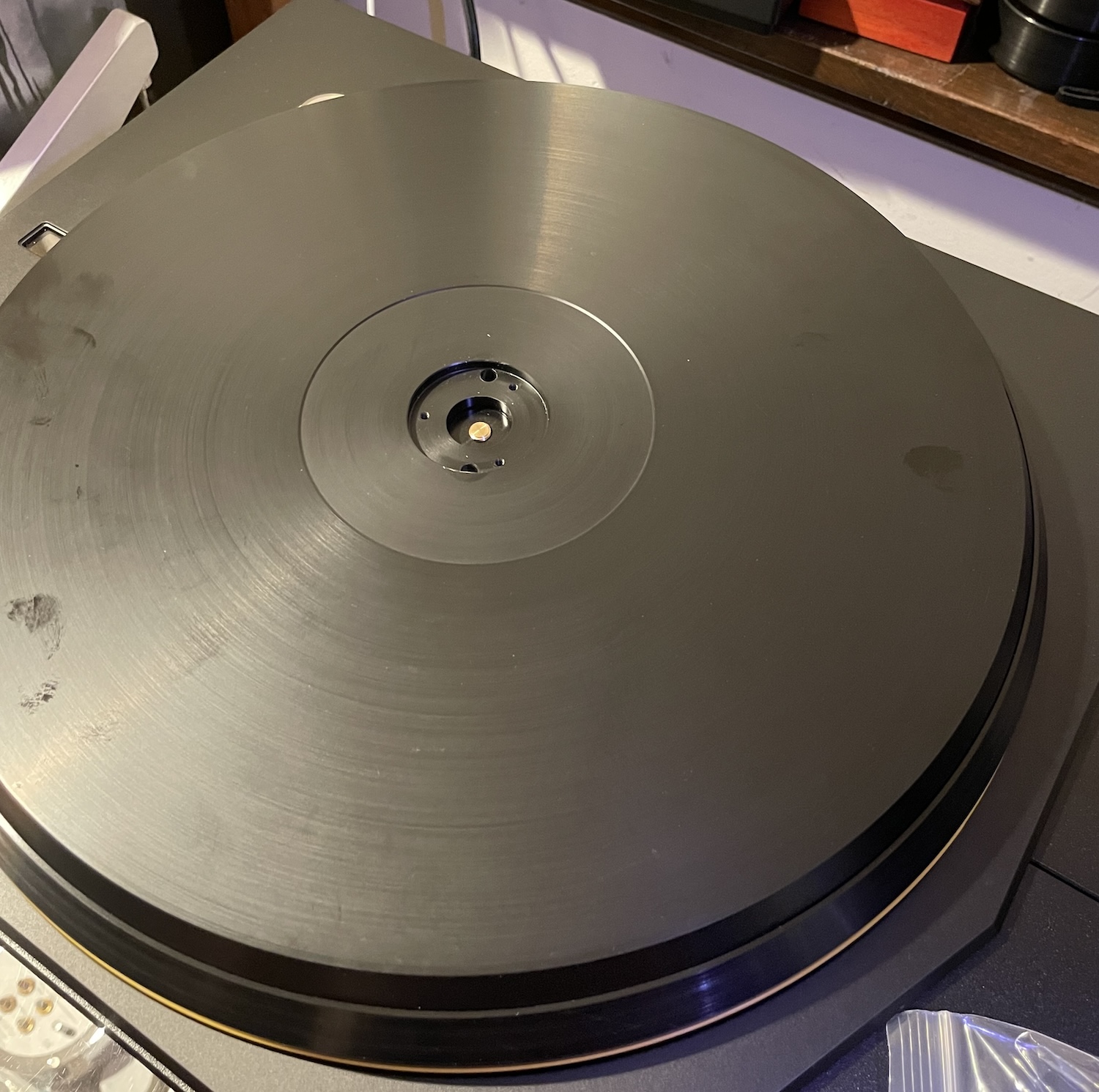
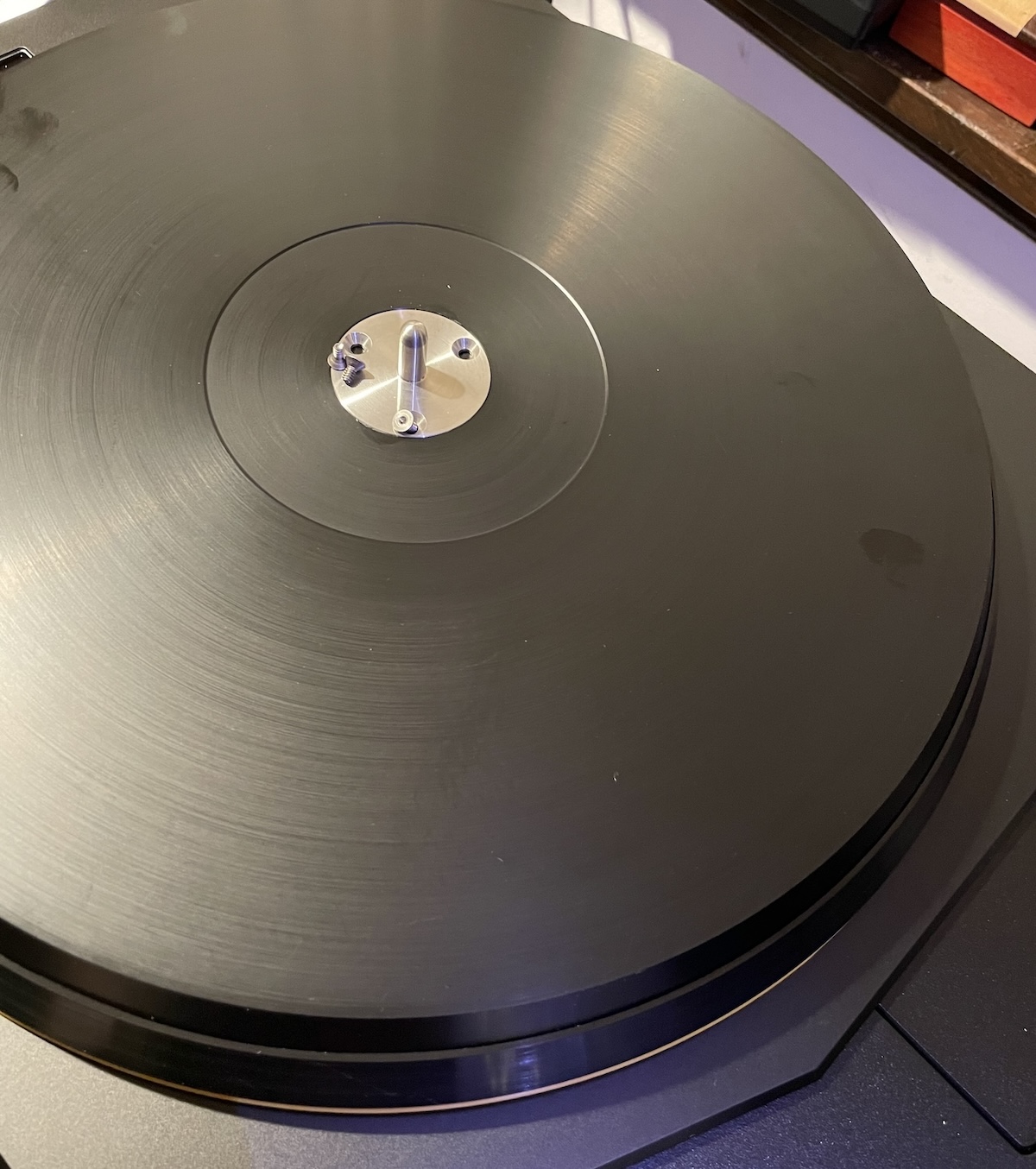 Three screws secure the spindle plate to the platter
Three screws secure the spindle plate to the platter
All this attention to detail is designed to provide a platter surface with a similar impedance to the record's for vibrational energy dissipation, under which is a high mass, balanced machined aluminum platter with a weighted periphery to improve the moment of inertia, topped with an isolated spindle. A great deal of careful engineering and attention to detail.
 The designer holds the platter on its side to show the multi-layered construction.
The designer holds the platter on its side to show the multi-layered construction.
A three phase A.C. synchronous motor drives the platter via an inboard electronics unit powered by an external "wall wart" that supplies to it low level voltage. The internal electronics powers the motor and generates the specified frequency sine wave for the chosen speed (the company's website erroneously says it's a "D.C. synchronous motor" and that the platter speed monitor is "optical" but neither is true). MasterDeck offers three speeds in addition to ± trim for each speed. Pressing the trim button will memorize and hold a chosen non-standard speed.
A Unique "Hybrid" Unipivot/Gimbal Bearing Tonearm With Patented Counterweight
Perkins designed for the MasterDeck a sophisticated 10 inch tonearm that allows full adjustability: VTA/SRA via the arm pillar and azimuth adjustability at the head shell, which is removable so you can have multiple cartridges set up and ready to use with relative ease and it doesn't involve a "wire-break" and multiple contact points. Anti-skating is of the "lever/weight variety and what's most important is that none of adjustability comes at the expense of rigidity.
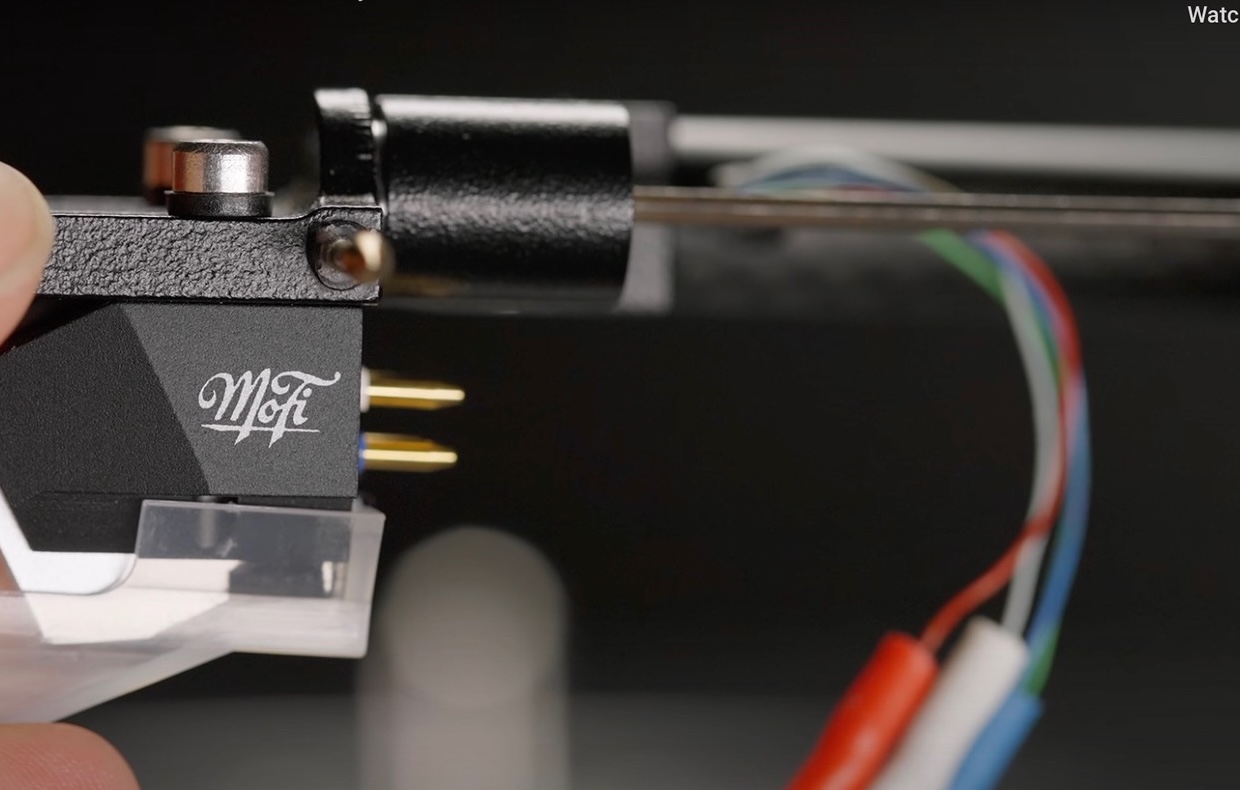 The head shell's cylindrical junction fits into the cup and is drawn tight with an allen head bolt (allen key shown in the photo). Before tightening, the head shell can be rotated to set azimuth. Markings allow future precise re-alignment as long as you've snapped a photo of it!
The head shell's cylindrical junction fits into the cup and is drawn tight with an allen head bolt (allen key shown in the photo). Before tightening, the head shell can be rotated to set azimuth. Markings allow future precise re-alignment as long as you've snapped a photo of it!
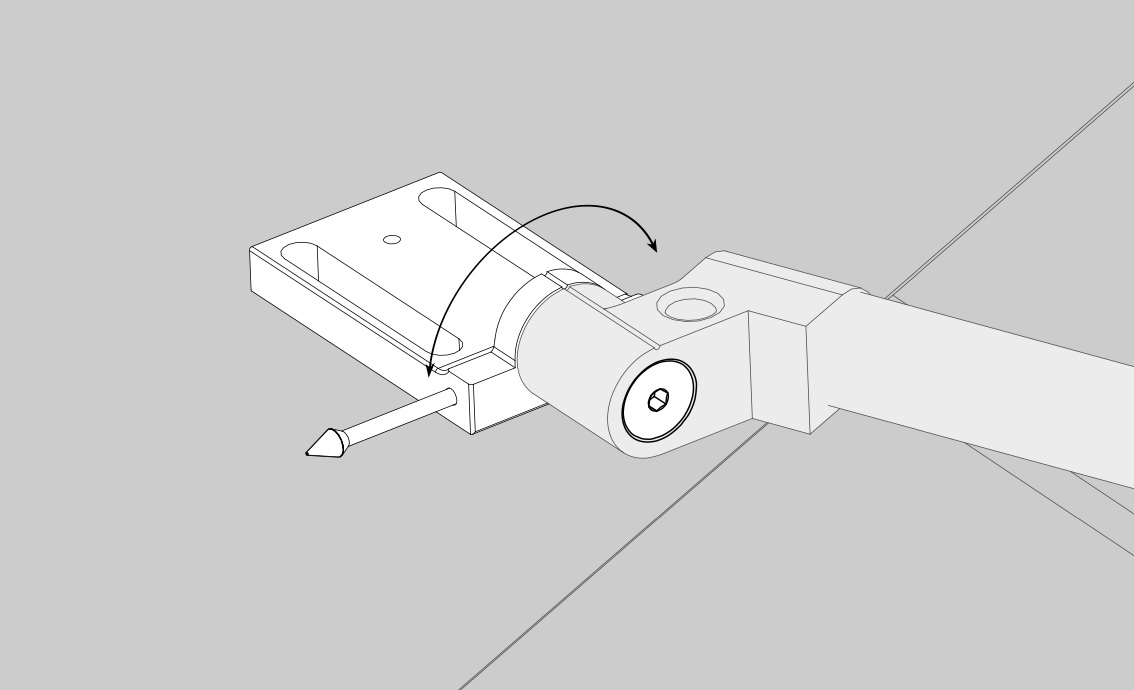
MasterDeck utilizes a variant of Spiral Groove's unique "Centroid" arm counterweight that because of its weight distribution can greatly shift the mass relative to the pivot point, which means the single counterweight can accommodate an unusually wide variety of cartridge weights. It's adjustable via a threaded shaft, which makes it super-convenient. As you screw it inward more of the counterweight mass moves forward towards the pivot point and vice-versa—more so than with a standard counterweight.
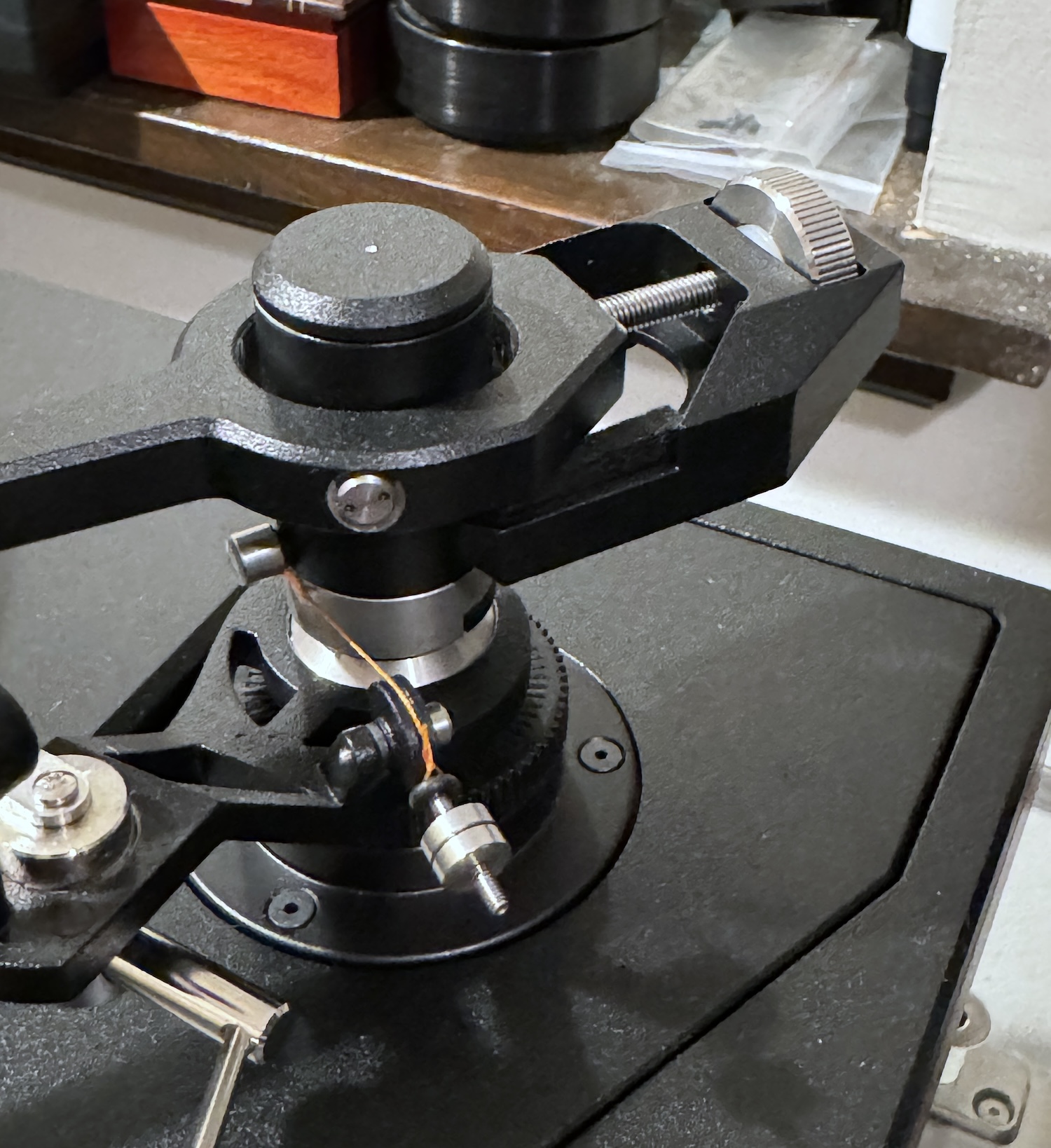
Lateral arm movement is via a modified unipivot arrangement that in addition to the standard "point in cup" adds two ruby balls situated within the bearing cup at approximately the "10:00" and "2:00" positions to increase stability and avoid the usual "unipivot lean". The yoke that controls vertical motion is a more standard gimbaled type bearing, but designer Perkins says it's a very carefully chosen one, somewhat unusual in this application.
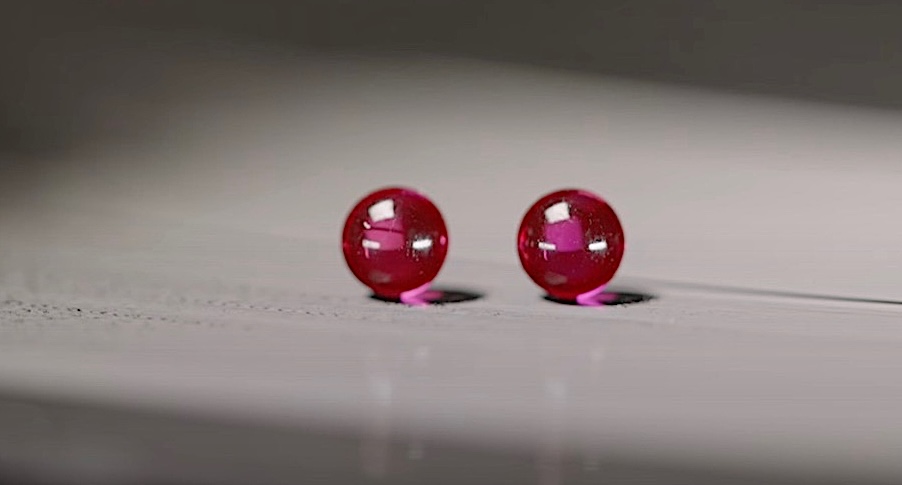
Though cylindrical on the outside, the carbon fiber arm tube's inner diameter goes from larger at the pivot housing to smaller at the head shell interface. Cardas provides the internal arm wire, which terminates in a DIN jack.
The threaded arm pillar fits into a collet-type base that grips it evenly and tightly as the locking screw turns. When it's loosened the arm will maintain its vertical position. Rotating the knurled black ring raises and lowers the arm when the collet is loose. Simple, well-executed VTA/SRA adjustability, though of course keep in mind when you raise or lower the pillar you are also affecting azimuth due to the head shell offset angle. Whatever you are hearing from changing VTA/SRA may be the result of that shift so again check azimuth. This has been a recorded message.
Set-up And Use
Set-up is relatively quick and easy. The four HRS (Harmonic Resolution Systems) designed and supplied height adjustable feet are said to provide "5.5 degrees of freedom" and so effectively "float" the turntable and offer "exceptional isolation from environmental vibrations and feedback". Once platter and arm have been installed, you level the base, attach the power supply and upon first turn on the 'table will go into calibration mode and then shut down. It will do so for 45 and 78 rpm the first time you select them. A window to the platter's left monitors speed from start up to chosen speed. Post calibration I used the RPM phone app to measure the turntable's speed and it was 33.3.
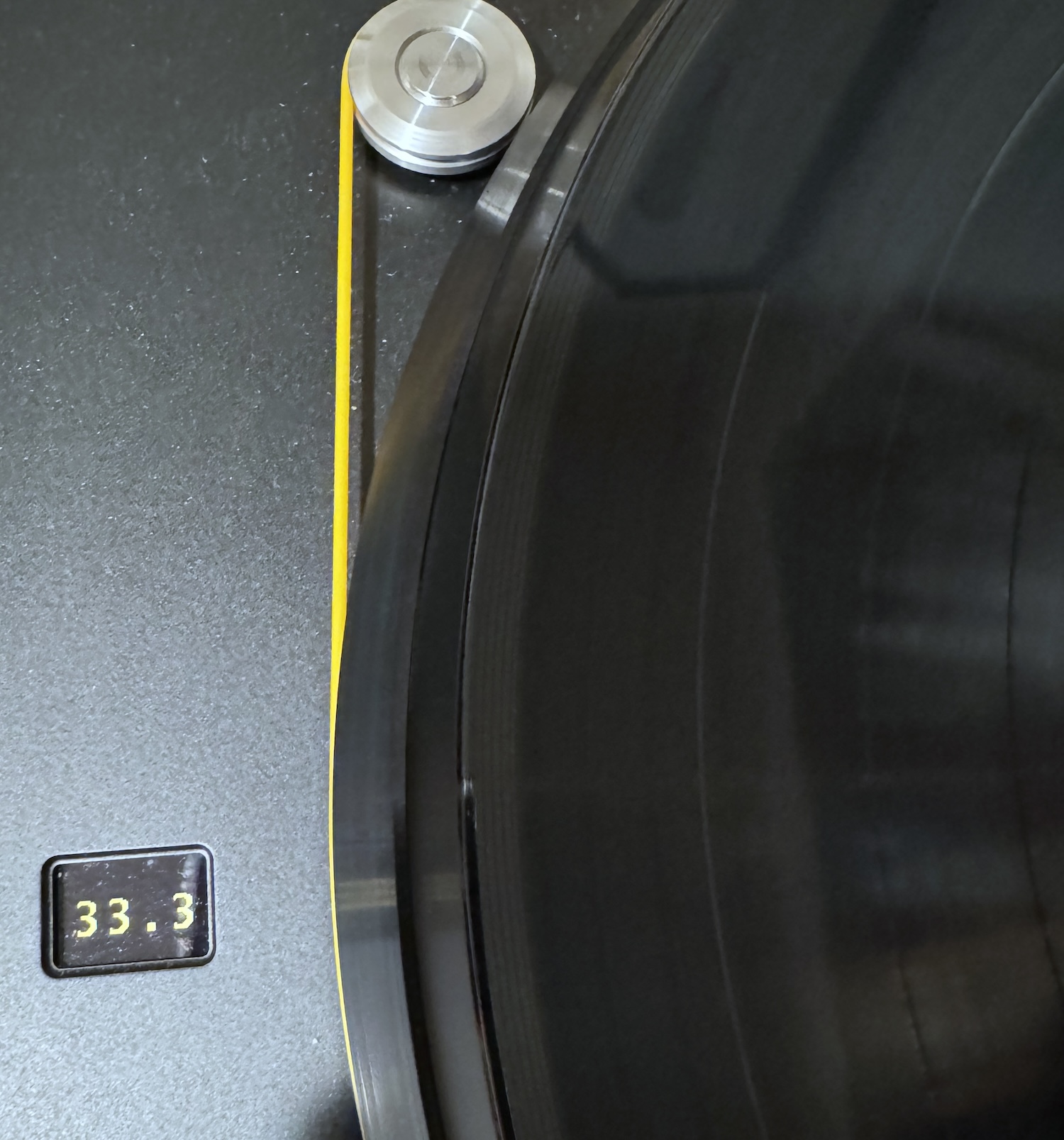
I chose to try the $6999 Ortofon MC Verismo, confident that the arm would treat it well and it did. While Allen Perkins read a magazine I set-up all parameters in short order confident that the first familiar record played would let me know how well the MasterDeck rendered the Verismo's excellent sonic performance.
I'm not sure how many $5995 turntable buyers will choose a more costly cartridge but they can and with the right peripheral set-up gear and with relative ease they can dial in every parameter. One cautionary note: since the head shell is unique to this design, if you think you might want to swap out head shells fitted with different cartridges, I'd buy the head shells with the turntable so you have them on hand.
Using the Masterdeck is an easy pleasure with one caution: the rest securely holds the arm, which is a good thing. However, it requires a strong pull to secure it and if you are not careful you can think the arm tube is in the rest but if not it can ricochet in the opposite direction towards the spindle and so return carefully to the rest.
Otherwise, select speed, push the button (which illuminates color coordinated with MoFi Electronics's Peter Madnick designed MasterPhono phono preamp). In the words, $12,000 gets you the excellent phono preamp and this turntable, both created by top industry designers.
Once I was certain the bearing was fully broken in (it pretty much came having been broken in, but just to be sure, I gave it many spins) I used the Shaknspin app and here are the results:
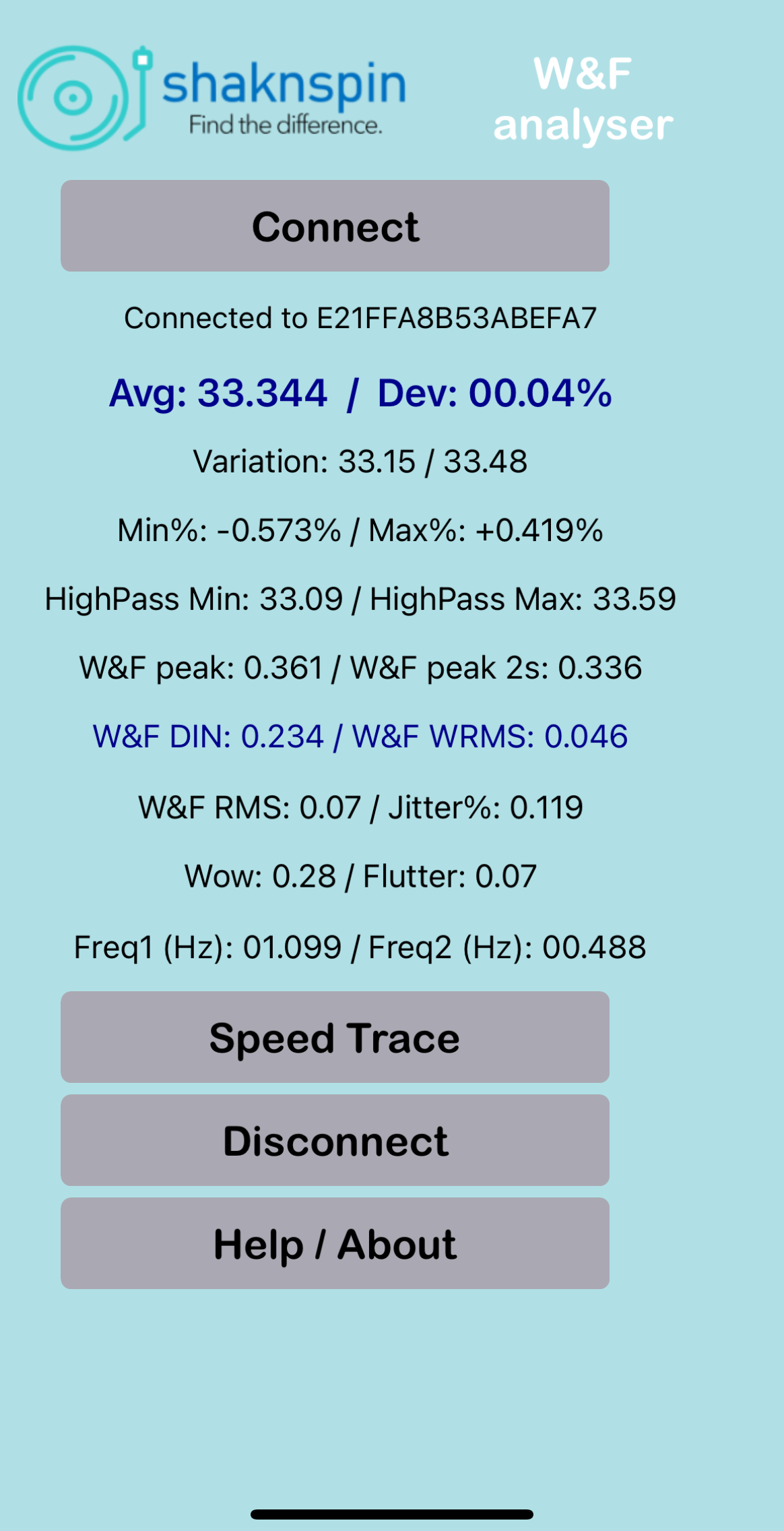 These are more than respectable wow and flutter and speed accuracy numbers—excellent actually—but speaking of $12,000 check out the Rega NAIA 's truly spectacular measurements, probably by far the best belt drive measurements I've seen, but at twice the MasterDeck's price!
These are more than respectable wow and flutter and speed accuracy numbers—excellent actually—but speaking of $12,000 check out the Rega NAIA 's truly spectacular measurements, probably by far the best belt drive measurements I've seen, but at twice the MasterDeck's price!
Musically Satisfying Sound
The designer is a drummer and a very good one. He brings his rhythmic and general musical sensibilities to his designs. I've been listening to them for decades. As I keep insisting in these turntable/arm reviews, these are "tuned systems". You can over damp the musical life out of a turntable, or underdamp and add non-musical life to it.
Having to design to a price point is not really in Perkins' designer DNA and though I purposely avoided discussing with him what compromises he made to get this one in on budget, whatever he did didn't compromise much in the final sonic presentation, especially in the areas that most concern him.
Obviously "rhythm'n'pacing" is of utmost importance to a drummer/turntable designer. Another is low noise and effective isolation. A turntable's rhythmic performance is determined as much by its speed consistency as it is by how it deals with extraneous vibrations both externally and internally generated.
The recently reviewed Stephan Crump album Slow Water auditioned on the MasterDeck. Only after it was published did I play the two record set on the reference OMA K3 with SAT CF1-12 arm. The MasterDeck's bottom end performance on that record and on all I played was firm, well-extended yet nimble and free from "one note" colorations.
Of course there was "more" from the big turntable but the music's general contours were not all that different, especially the overall timbral balance, though there was a bit of additive upper mid-bass warmth.
The Verismo is not a "rich" sounding cartridge like some others. It's more neutral to slightly cool but with a pleasing timbral balance, impressive transparency, sound staging excellence and transient precision. The Replicant 100 stylus delivers the details.
The MasterDeck accurately delivered the Verismo's sonic personality, especially its transient clarity and speed, perhaps adding a bit of warmth on bottom without slowing down rhythmic excitement. It's a sonic balance most listeners will appreciate and it was only noticeable in a comparison. Otherwise the MasterDeck did a great job of getting out the way to where I was more than happy to listen long term and to every musical genre, particularly impressed by its background quiet and overall effortlessness.
At audio shows, especially in Munich, people hand me records. It's a nice gesture but I've ended up with a shelf full of unplayed records. Finding time to play unsolicited records is difficult but I recently decided to pull some out at random and give a listen. One is by an outfit called Sob & The Czyks with the somewhat cumbersome title A Soulful Journey Can't Stop Loving You on Route 66 Vol. II (Swingin' gate SG-002). I didn't have to look to know it was obviously an all-analog recording. While it played I read the annotation. It was mixed live as the group played to a Studer C37 using great microphones.
 Musically, it's "audiophile fare", well played combination of trad jazz and swing covers of familiar material but the sound is 11 all the way; 12 if it could go there. The record has an "in the studio" sound with particularly powerful, deep bass from kick drum and bass. The female vocalist is "right there". I'll bring this to a show or two because it's guaranteed to please sonically and the music sometimes swings pretty good in a "trad" way. The singer, Denise Gordon is awfully good and in a ridiculous way her phrasing reminded me of Tom Waits on his Asylum album Small Change. I was able to track down the guy who handed me the record through the information on the jacket and if you're interested go here . Otherwise I can tell you the MasterDeck was not at all phased by this record's deep, powerful bass, wide dynamics and almost "direct to disk" sonic personality.
Musically, it's "audiophile fare", well played combination of trad jazz and swing covers of familiar material but the sound is 11 all the way; 12 if it could go there. The record has an "in the studio" sound with particularly powerful, deep bass from kick drum and bass. The female vocalist is "right there". I'll bring this to a show or two because it's guaranteed to please sonically and the music sometimes swings pretty good in a "trad" way. The singer, Denise Gordon is awfully good and in a ridiculous way her phrasing reminded me of Tom Waits on his Asylum album Small Change. I was able to track down the guy who handed me the record through the information on the jacket and if you're interested go here . Otherwise I can tell you the MasterDeck was not at all phased by this record's deep, powerful bass, wide dynamics and almost "direct to disk" sonic personality.
I picked up for almost nothing a really clean copy of Gerry Mulligan '63 The Concert Jazz Band (Verve V6-8515), which might as well have been released on RCA. Ray Hall recorded it at Webster Hall December of 1962 and what a band! Clark Terry, Doc Severinsen, Bob Brookmeyer, Jim Hall among the players. Mulligan plays baritone sax and piano. As the notes point out the colors are Ellingtonian but the sound is Mulligan. In today's jazz climate it's strictly "old school" but seriously pleasurable and again, the MasterDeck delivered this recording full bore. Muliigan's piano is center stage and he does some heavy pounding that didn't phase the tonearm as the Verismo drove through the heavily modulated grooves, perfectly tracking all.
Overall the MasterDeck's background quiet was what I expect at a much higher price point. It made really pleasurable listening to quiet recordings like Pentangle's Sweet Child (Transatlantic TRA178). You know something's working well when it inspires you to pull records, which is what led me to play that record. Of course that led to The Incredible String Band and pretty soon I was down the late '60s British folkie rabbit hole and that's what it's all about! Music jumps out from black backgrounds and all the mechanics behind vinyl playback disappear. That's also what it's all about.
Conclusion
MoFi Electronics' MasterDeck is an ambitious design by an industry veteran who brings great expertise to the task and succeeds in delivering to the company a fully thought out, well conceived belt drive turntable design plus a 'bespoke' fully adjustable arm that doesn't sacrifice rigidity in either set-up or replaceable head shell convenience. It's all been well thought through and the execution by the manufacturing team in Ann Arbor Michigan is also excellent. The fit'n'finish is "top shelf" including the wood accent frame available in two varieties.
This is a turntable that sounds as good as it looks and feels, well maybe even better, and it does look good. That it could be designed and produced in America for $6000 is impressive. Right now it's sold out. I hope they build some more quickly! The MoFi MasterDeck is among the best under $10,000 turntables you can buy and I'll leave it at that.
Specifications
SPECIFICATIONS
Motor:
Belt Drive, DC Synchronous
Speeds:
33.3 RPM, 45 RPM, 78 RPM with trim adjustment +/-
Platter:
14.35 lb Delrin® coated Aluminum
Dustcover:
No
Power Consumption:
< 5W
Dimensions:
20” x 5.125” (~ 6.250” with tonearm.) x 15.125"
Weight:
37.4 lbs
TONEARM SPECIFICATIONS
Tonearm Type:
Unipivot/Gimbal hybrid
Overhang:
0.71" (18mm)
Offset Angle:
22.8°
Cartridge Weight Range:
5g – 14g


